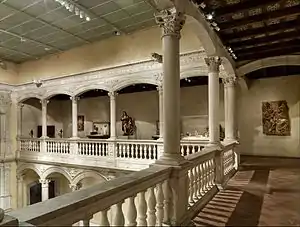Castillo de Vélez-Blanco
Castillo de Vélez-Blanco is a remarkable example of Spanish Renaissance Castle. It is located in the town of Vélez-Blanco, province of Almería, in the autonomous community of Andalusia, Spain.


History
It was built by Pedro Fajardo y Chacón after being ranked as I Marquis of Los Vélez by the Catholic Kings after the Granada War. Works started on 1506 and finished on 1515. It has works by florentian Jacopo Florentino and Martín Milanés, who worked also in the Royal Chapel of Granada. The castle was built on the foundings of a previous moorish castle set on a hill overlooking the town and only the cistern and some of the castle walls were used for the new castle. Works started in late Gothic style, soon moving to early Renaissance and although its outside resembles a castle it was built as a refined palace in the inside.[1]
It´s most remarkable feature is the patio, preserved in the Metropolitan Museum of Art. It influenced also the near La Calahorra Castle patio build by Rodrigo Díaz de Vivar y Mendoza, 1st Marquis of Cenete and now both patios are considered the best early Renaissance examples in Spain. Today, it´s Torre del Homenaje keep is an outstanding feature, over 65 feet (20 m) high, an emblematic element of the castle and a symbol of the power over the wealthy aristocrat's estate. The stone structure, had wooden stairs, which could be removed in case of danger isolating the upper level as a last defense. There is a vast number of decorative elements topping its battlements.[2]
In 1764 the Marquis of Los Velez donated a cannon for the Church of Velez Rubio church bells.[3] The property was ever since neglected, during the Peninsular War the rich interior was subject of looting and at during the XIX century the Patio was used to store grain and reed, as found in a document kept in the Medina Sidonia Foundation library.[4]
In 1931 it was listed as a Spanish Bien de Interés Cultural monument. The building has been restored in stages during the second half of the 20th century, including the floors of the towers. In the early XX century it´s valuables were sold by it´s owners mainly to french antique dealers. Since 1945 the Spanish Renaissance marble patio and artesonados or Spanish ceilings are held by the Metropolitan Museum of New York after being bequested by banker George Blumenthal to the museum. In 2019 the Spanish National Research Council found that one of Blumenthal's Spanish Ceilings is now owned by the country of México and is in the Instituto Cultural Helénico of México City. It´s Labours of Hercules and Thriumphs of Caesar friezes were found in 1992 in the basement of the Musée des Arts Décoratifs of Paris, where they are now exhibited.[5][6][7]
References
- Rodríguez, Rodríguez Gómez; Martín, Antonio Prieto (2012). Cuaderno de ayer (in Spanish). Universidad Almería. ISBN 978-84-8240-927-6.
- www.metmuseum.org https://www.metmuseum.org/art/collection/search/199003. Retrieved 2020-10-11. Missing or empty
|title=(help) - Ayén, Fernando Palanques y (1909). Historia de la villa de Vélez-Rubio (en el antiguo marquesado de los Vélez): desde los tiempos primitivos hasta nuestros días (in Spanish). Imp. á cargo de J. García Ayén.
- Press, Europa (2019-01-16). "Descubren un croquis inédito del Patio del Castillo de Vélez-Blanco (Almería) de principios del siglo XIX". www.europapress.es. Retrieved 2020-10-11.
- "Frieze from the castle of Vélez Blanco: The Birth of Hercules". madparis.fr. Retrieved 2020-10-11.
- "Un arquitecto almeriense halla en México un artesonado del Castillo de Vélez Blanco". Ideal (in Spanish). 2019-07-14. Retrieved 2020-10-08.
- www.metmuseum.org https://www.metmuseum.org/es/art/collection/search/199003. Retrieved 2020-10-08. Missing or empty
|title=(help)
- El Renacimiento en Andalucía. Jornadas Europeas de Patrimonio (2006). Editado por la Consejería de Cultura de la Junta de Andalucía.
External links
![]() Media related to Castle of Vélez-Blanco at Wikimedia Commons
Media related to Castle of Vélez-Blanco at Wikimedia Commons